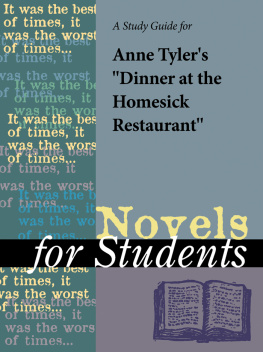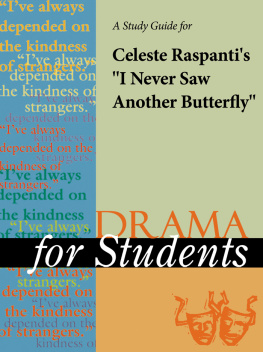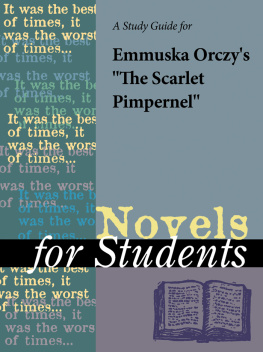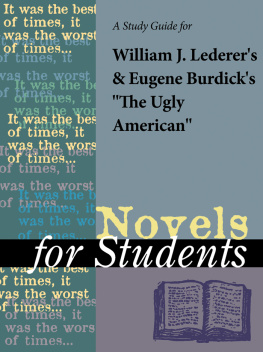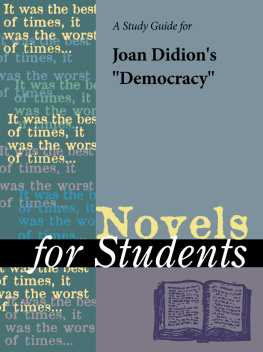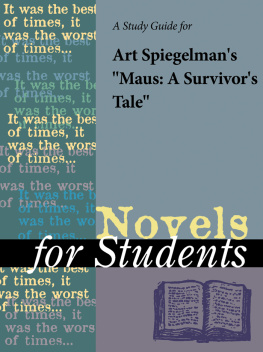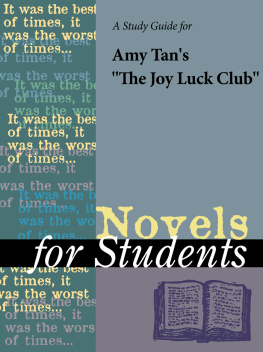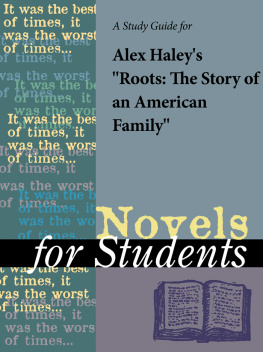TABLE OF CONTENTS
Guide
Novels for Students, Volume 2
Since this page cannot legibly accommodate all copyright notices, the acknowledgments constitute an extension of the copyright notice.
While every effort has been made to secure permission to reprint material and to ensure the reliability of the information presented in this publication, Gale Research neither guarantees the accuracy of the data contained herein nor assumes any responsibility for errors, omissions or discrepancies. Gale accepts no payment for listing; and inclusion in the publication of any organization, agency, institution, publication, service, or individual does not imply endorsement of the editors or publisher. Errors brought to the attention of the publisher and verified to the satisfaction of the publisher will be corrected in future editions.
This publication is a creative work fully protected by all applicable copyright laws, as well as by misappropriation, trade secret, unfair competition, and other applicable laws. The authors and editors of this work have added value to the underlying factual material herein through one or more of the following: unique and original selection, coordination, expression, arrangement, and classification of the information.
All rights to this publication will be vigorously defended.
Copyright 1997
Gale Research
835 Penobscot Building
645 Griswold St.
Detroit, Ml 48226-4094
All rights reserved including the right of reproduction in whole or in part in any form.
This book is printed on acid-free paper that meets the minimum requirements of American National Standard for Information SciencesPermanence Paper for Printed Library Materials, ANSI Z39.48-1984.
ISBN 0-7876-1687-7
ISSN 1094-3552
Printed in the United States of America
10 9 8 7 6 5 4
Dinner at the Homesick Restaurant
Anne Tyler
1982
Introduction
Critics generally consider Dinner at the Homesick Restaurant, Anne Tyler's ninth novel, to be among her best work. It won the PEN/Faulkner Award for fiction and was nominated for a National Book Critics Circle award and the 1983 Pulitzer Prize. Also a commercial success, it has to date sold more than 60,000 copies in hardcover and more than 655,000 in paperback. Published in 1982, the medium-length fiction spans several decades in the history of the Tull family of Baltimore, Maryland. Often compared to William Faulkner's novel As I Lay Dying, the narrative begins with 85-year-old Pearl Tull, blind and on her deathbed, attempting to reconcile with her role as a deserted wife and single parent. Will her three grown children Cody, Jenny, and Ezraforgive her for sometimes being a physically and verbally abusive mother? Told from alternating points of view, Dinner at the Homesick Restaurant is ultimately about how growing up in an unconventional, turbulent family affected three children in very different ways.
Although many critics considered the novel less optimistic than her other work, it drew much praise for its psychological insight, rich characterization, well-developed plot structure, and impressive handling of multiple points of view. Like many of her other novelsincluding Earthly Possessions, Searching for Caleb, and The Accidental TouristDinner at the Homesick Restaurant is about the burden of a person's past, be it personal, familial, or historical.
Author Biography
Anne Tyler was born on October 25, 1941, in Minneapolis, Minnesota, to chemist Lloyd Parry Tyler and social worker Phyllis Mahon Tyler. The daughter of Quakers, hers was a somewhat nomadic childhood, living in such places as Chicago; Duluth, Minnesota; and Cleo, North Carolina (in which her family lived in an experimental collective community in the mountains). When Anne was eleven, her family settled in Raleigh, North Carolina. Adapting to this relatively cosmopolitan environment did not come easily, since up until that time, the young girl was unfamiliar with such conveniences as the telephone. Tyler ultimately adjusted, sometimes doing field work on tobacco plantations and observing the quirks and dialects of her coworkers. In high school, she planned to become a book illustrator. Phyllis Peacock, one of her English teachers, also instructed Reynolds Price, who became a successful novelist and a friend of Tyler's.
Attending Duke University on full scholarship, Tyler took a writing course taught by Reynolds Price and majored in Russian. In 1961, she graduated Phi Beta Kappa with a B.A. and briefly pursued graduate work at Columbia University. From 1962 to 1963, Tyler worked as a Russian bibliographer at Duke University; in May, 1963, she married the Iranian medical student and novelist Taghi Mohammed Modaressi. While her husband completed his residency at McGill University in Montreal, Tyler took a job as the assistant to the librarian of McGill's Law Library.
In Montreal, Tyler wrote her first two novels, If Morning Ever Comes (1964) and The Tin Can Tree (1965), neither of which received much critical attention. However, the critics who took notice praised the author's maturity and anticipated her future success. By the time Tyler had published her fifth novel, Celestial Navigation (1974), critics such as Gail Godwin and John Updike agreed she was a literary force to be reckoned with. With the publication of Dinner at the Homesick Restaurant (1982), her place as one of the best and most significant American novelists of her generation seemed secure. In addition to several novels, more than fifty of Anne Tyler's short stories have been published to date.
Along the way, Tyler has received countless literary awards, including the Mademoiselle award for writing (1966); Award for Literature, American Academy and Institute of Arts and Letters, (1977);Janet Heidinger Kafka prize (1981), PEN/Faulkner Award for Fiction (1983), and the Pulitzer Prize for Fiction (1989). With the latter award and the 1990 motion picture The Accidental Touristbased on Tyler's novel of the same namesome of the writer's popularity has spread into the American mainstream.
While not an easy author to categorize, Tyler has often been described as a Southern writer, setting her early novels in the South, and is frequently compared to William Faulkner and Eudora Welty. In spite of her great productivity, she remains something of an enigma: an extremely private person who grants few interviews and shuns most public appearances.
Plot Summary
Part I: Pearl
Dinner at the Homesick Restaurant is the story of the Tull family of Baltimore, Maryland, told first from the perspective of Pearl Tull, and then from the perspective of each of her children, Cody, Ezra, and Jennifer. Because the novel is told from differing points of view, readers often witness the same event several times, with different emphasis.
Chapter One, "Something You Should Know," opens as Pearl Tull lies dying in her Baltimore home. Her son Ezra sits next to her. She recalls her life, not in chronological order, but in the way memory works, one memory sparking the next. She begins by recalling how she had almost lost her oldest son Cody as a baby and that near loss was the catalyst for her having more children. From this memory, she moves farther back in time and recollects meeting and marrying Beck Tull, a traveling salesman. Pearl was thirty at the time, nearing spinsterhood. Her marriage did not turn out as she had planned. Beck moved the family from place to place and neither Pearl nor her children were able to form connections with other people. Finally, Beck tells Pearl that he does not want to be married any longer, and he leaves the family, now settled in Baltimore. Pearl finds herself a single mother with children aged fourteen, eleven, and nine. In order to keep up the appearance of a normal marriage, Pearl lies to her children, family, and friends, saying Beck is away on business. Pearl recalls a time when the family was together in the country and Beck was teaching Cody how to use his new bow and arrow. Cody accidentally shoots his mother in shoulder. The wound festers; when Pearl has it treated, she nearly dies from an allergy to penicillin.

